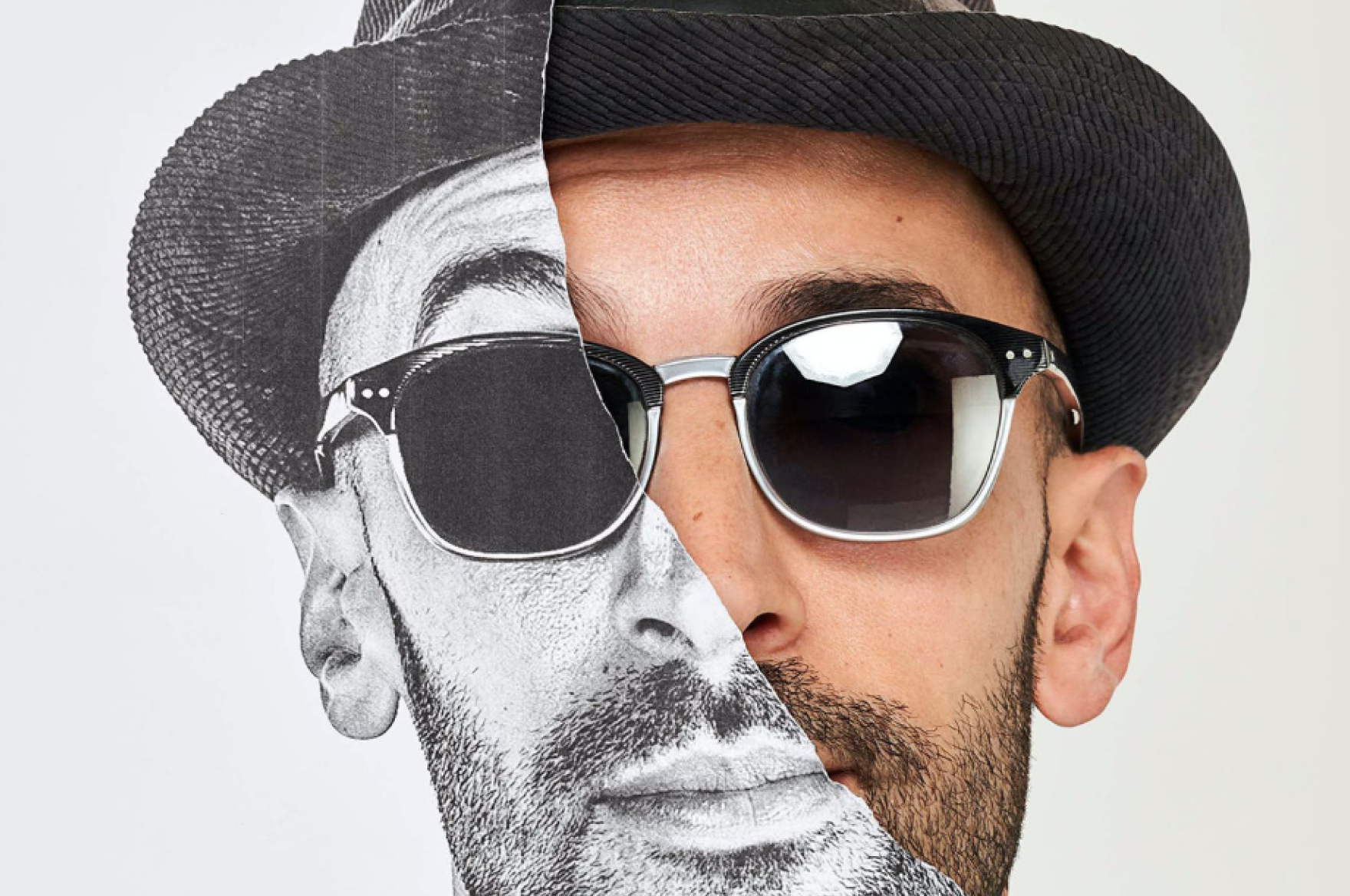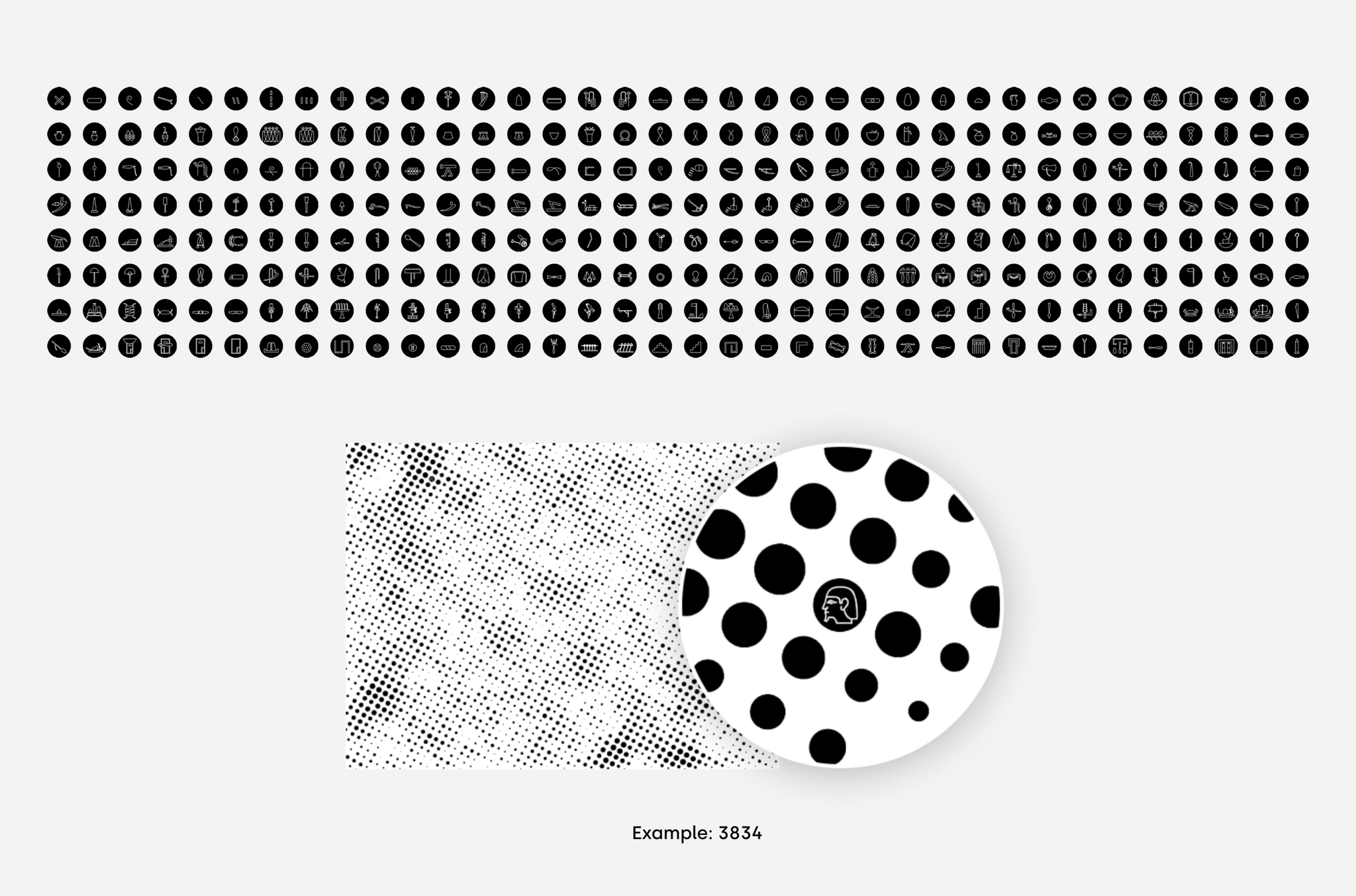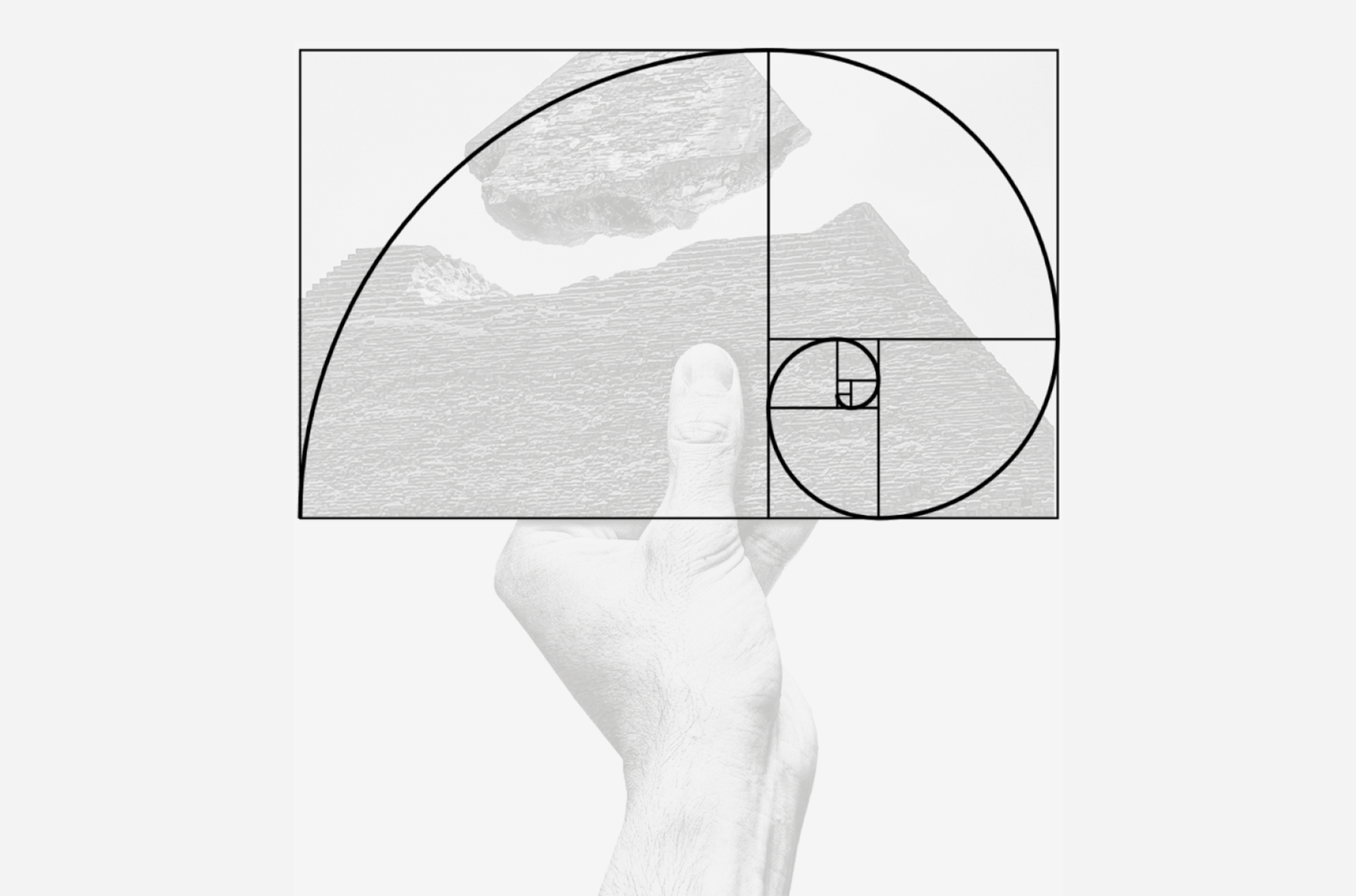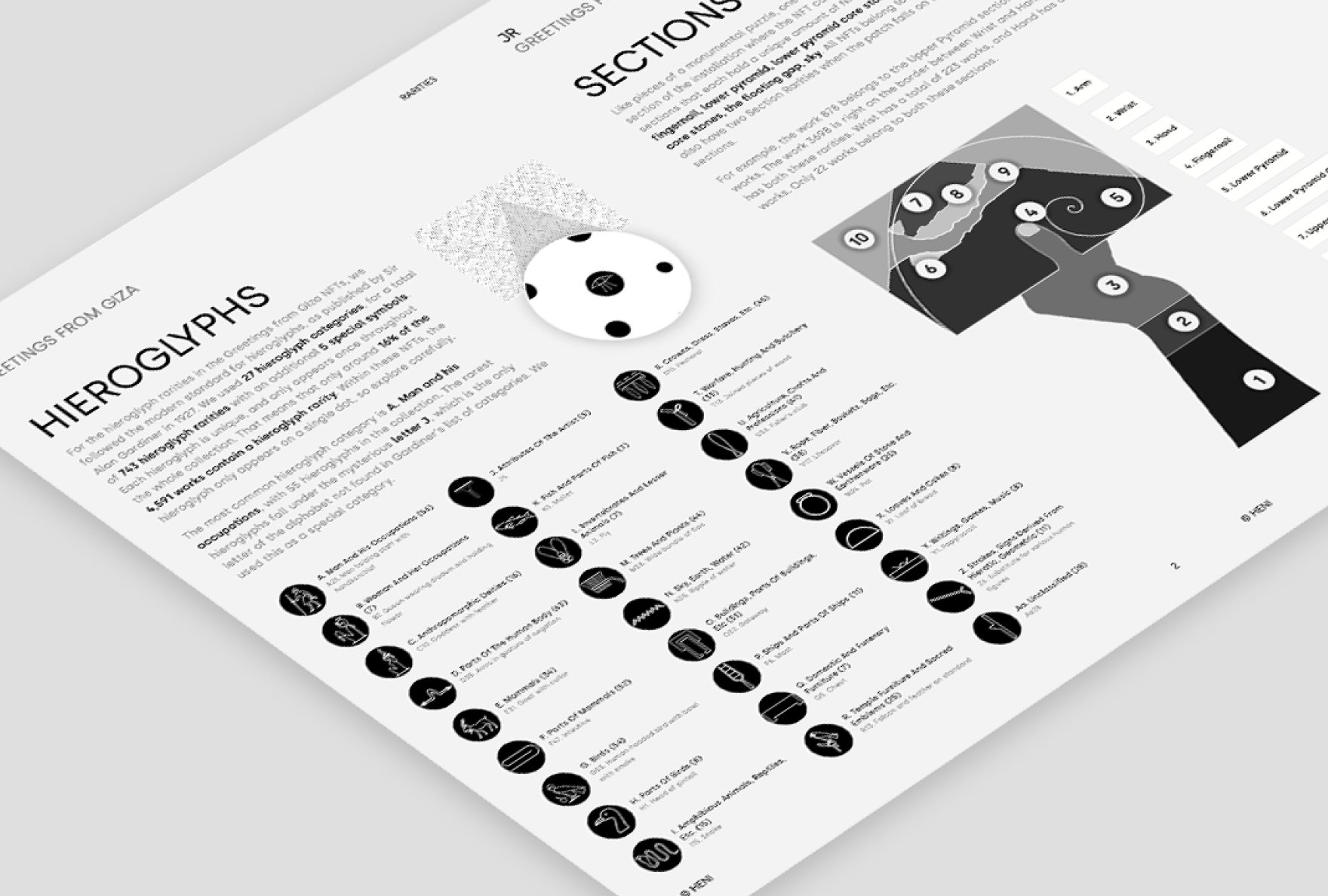

GREETINGS FROM GIZA
JR
Greetings from Giza
HENI is delighted to present Greetings from Giza, the first NFT collection by JR. For the first time, the enigmatic artist is able to make ephemeral art persist through the use of blockchain. Greetings from Giza is a multi-layered collection that blurs the lines between the public and digital space, inviting the audience to not just own, but become part of the artwork.
On October 21st, the project and application period are launched with the installation of a large-scale public work in Giza, Egypt. In line with the years since this historic monument was constructed in 2570 BC, the artwork has been divided into 4,591 Greetings from Giza NFTs, each showing a unique detail of the work made up of black and white shapes.
The collection is on the Palm blockchain, a token-powered ecosystem for NFTs which has a two-way bridge to Ethereum, and features low gas costs, fast transaction finality, and 99% more energy efficiency than proof of work systems.
JR
In his own words, French artist JR creates ‘infiltrating art’ and is driven by an ambition to bring art to as many people as possible. Hence, he creates epic installations all over the world, involving hundreds of thousands of people and blurring the line between artist, artwork, spectator and participant.

Some of his best known works include a gigantic optical illusion transforming the Louvre, a thought provoking installation at the US-Mexico border fence, or Inside Out, a global participatory art project involving huge portraits of over 420,000 participants from 138 countries. As he remains anonymous and doesn’t decipher his impressive installations, the artist intentionally leaves space for interpretation between the subject and the subjected. That is what the work of JR is about, raising questions.
"For my first NFT ever, it’s amazing to be able to work on such an historic monument and to connect it with a technology that I never imagined would exist when I started my work as an artist 20 years ago."
From the suburbs of Paris to the Pyramids in Egypt
The artistic journey of JR starts in his hometown of Paris, France. His commitment to community, collaboration, and civic discourse was already visible in his early photographic projects. By pasting large photocopies in the streets of the country’s capital, he freed his art from the restraints of museums or galleries and captured the eye of the casual passerby. By bringing the faces of young people from underrepresented communities to prominence, JR brought attention to the misrepresentation of these individuals in the media, thereby also challenging the public's assumptions and biases. Shortly after, JR expanded his art beyond France and made the world his gallery.
Now, JR is an Oscar-nominated filmmaker, TED Prize winner, and was named one of Time's 100 most influential people in 2018. His practice is rooted in his deep commitment to collaborating with individuals and communities alike. He has received critical acclaim for his global art projects that bring together diverse groups of participants and create dialogue around critical social issues.
The logical next step for JR was to bring his art to the world of NFTs. The artist’s unique ability to make the viewer part of the artwork, has found a new meaning with the opportunities that NFTs offer. For the very first time, people are able to own a piece of the public installation. With Greetings from Giza, JR plays on the balance between the macroscopic and the microscopic, the individual experience with the universal.
4,591 Pieces Of History
The impressive artwork Greetings from Giza is made of a steel structure and mesh and it stands in front of the Pyramid of Khafre in Giza. This famous pyramid, constructed 4,591 years ago in 2570 BC, serves as the tomb of the Fourth-Dynasty pharaoh Khafre. The mesmerizing installation shows a never before seen perspective of the pyramid, and is made using countless dots and shapes of varying sizes. Using a combination of a specialised algorithm and artistic interpretation, HENI and JR carefully divided the artwork into 4,591 pieces of varying sizes, and in doing so created unique artworks in the form of NFTs.
Like pieces of a monumental puzzle, one of the rarities for the NFTs will be the section of the installation where the detailed NFT can be found. We have identified 10 different sections that each hold a unique amount of NFTs, which are: arm, wrist, hand, fingernail, lower pyramid, lower pyramid core stones, upper pyramid, upper pyramid core stones, the floating gap between the pyramid sections, sky. All NFTs belong to a section, but some works can also have two Section Rarities when the patch falls on the border between two sections.
To ensure that each NFT carries the significance that JR envisioned, they all have a unique combination of size, dots and detail. The example below shows how NFT 210 is part of the upper section of the pyramid. Although the NFT is a piece of a bigger puzzle, the intricate pattern of dots have their own visual impact, and even change in appearance depending on the level of detail shown.
Patches

Sections

Hidden Messages
One of the most fascinating aspects of the Greetings from Giza artwork, is the rich history of the subject matter. Paying homage to the cultural impact of Ancient Egypt, which spanned over 3,000 years, JR wanted to include one of the most recognisable characteristics of this historic civilisation: hieroglyphs.
In 1927, the Egyptologist Sir Alan Gardiner published the book called ‘Egyptian Grammar: Being an Introduction to the Study of Hieroglyphs’, which outlined what we now consider the modern standard for hieroglyphs. Using the letters of the alphabet as categories, he carefully described the hieroglyphs and attributed each to their appropriate category.
For the Greetings from Giza NFTs, we followed Gardiner’s publication to create 26 hieroglyph categories, for a total of 738 hieroglyph rarities with an additional 5 special symbols that JR created. Each hieroglyph is unique, and only appears once throughout the whole collection. That means that only around 16% of the 4,591 works contain a hieroglyph rarity. Within these NFTs, the hieroglyph appears on a single dot, so explore carefully to discover the hidden hieroglyphs. Explore all the different rarities here.
Although Gardiner used the known alphabet letters A-Z, he did make two changes, so we did too. First of all, he added an extra category for ‘unclassified’ symbols, and named the category Aa. More interestingly, he did not include the letter J into his list of categories. This historic happenstance was a perfect fit with the artist whose name begins with this very letter, JR. For this reason, the category J is attributed to JR and holds the rarest symbols of all rarities. Only 5 of these special motifs, created by JR, can be found in the Greetings from Giza collection.

Divine Proportions
The final rarity type for the Greetings from Giza collection has just as much historical significance as the hieroglyphs. The infamous golden ratio, also known as the divine proportion, has been a central topic of study and research for many millennia, and can be found in both natural objects and man-made systems.
In ancient Egypt, the golden ratio also played a key role in the theories revolving around the building of pyramids. For example, the proportions of The Great Pyramid of Egypt have been shown to be within miniscule margins of a golden ratio-based pyramid.
For the artwork of Greetings from Giza, JR drew inspiration from the golden ratio, carefully composing an image that followed the proportions. A thin white line over the top part of the artwork shows the outlines of the golden spiral. Much like the historical and natural occurrences of the golden ratio, it is not always easily found until one knows what to look for.

Rarities
The ’Greetings from Giza’ NFTs differ not only because of their individual patterns showing variously sized shapes and spots, but also through their rarities. The rarity categories include the section of the installation in which the NFT can be found, a historic list of hieroglyphs containing 743 hieroglyphs which each only appear once across the project, the secretive ‘J’ category that shows 5 special artist attributes, and finally the presence of the illustrious golden ratio.

